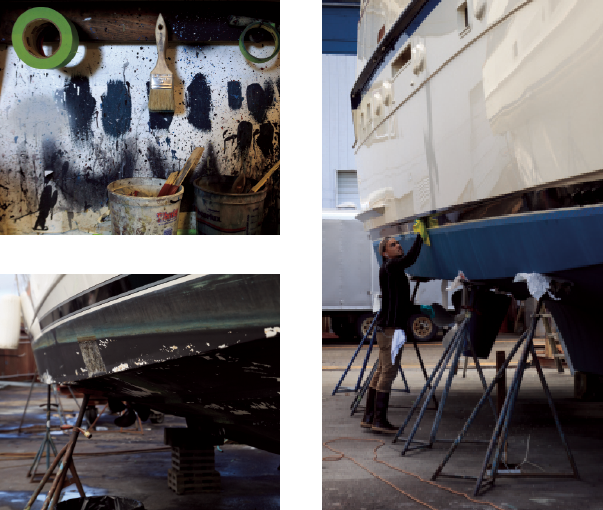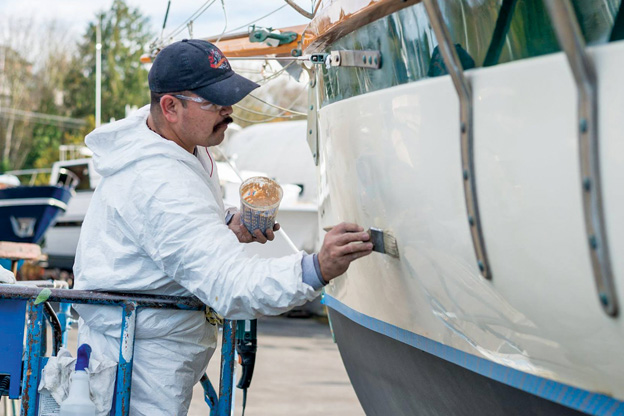A big change in boating is coming, are you ready?
// By Peter Scrhappen
Copper, that reddish metal you may remember from the periodic table, has been used in the maritime industry since at least the 18th century when the British Royal Navy adhered copper plates to their hulls to protect them from shipworms and other marine growth.
Copper has worked so well that it remains in most of the bottom paint you will find on store shelves. Why? Copper, like tributyltin (which was phased out in 1988) and zinc, is a biocide. “Bio” means life and “cide” means killing. But these days, copper may be a victim of its own success. While it’s great at killing life on your hull, paint can leach into the environment.
 “Even in extremely small concentrations, copper is a dangerous pollutant for marine life, especially our salmon. In many cases, it’s even more toxic than lead,” says Chris Wilke, executive director of the Puget Soundkeeper Alliance. He’s been looking at this issue for years and came to the same conclusion that the Northwest Marine Trade Association (NMTA) arrived at in 2011 — that copper should be phased out of paint.
“Even in extremely small concentrations, copper is a dangerous pollutant for marine life, especially our salmon. In many cases, it’s even more toxic than lead,” says Chris Wilke, executive director of the Puget Soundkeeper Alliance. He’s been looking at this issue for years and came to the same conclusion that the Northwest Marine Trade Association (NMTA) arrived at in 2011 — that copper should be phased out of paint.
A 2007 study from the National Oceanic and Atmospheric Administration found that copper disrupts a young salmon’s ability to smell. According to the study, salmon swimming through dissolved copper lose the ability to smell their prey. Salmon also use their sense of smell to locate their home stream and reproduce.
“If we know that copper is bad, and if we know that boatyards are continually struggling to make the benchmarks in their boatyard permit, why not try an approach that addresses the pollutant at its source? For us, that was looking at the paint in the can and not copper at the end of the pipe,” says Jim Brown, chair of the Clean Boating Foundation board and one of the original core members of the group that put forward legislation to phase out copper-bottom paint.
Washington’s Department of Ecology(Ecology) has scrutinized copper on industrial sites for decades. When it comes to the state’s 69 boatyards, Ecology is scared by how much copper and zinc is found in water samples taken during a storm. Any more than 147 parts per billion of copper in a sample exceeds the benchmark. If that happens twice during the five-year permit, the boatyard must take corrective action, which can cost tens of thousands of dollars for engineering reports and the purchase and upkeep of a filtration device. Keep in mind that 147 parts per billion is next to nothing. To put this amount in perspective; it is equivalent to three drops of food coloring in 50,000 liters of water.
When it came to the legislation, Senate Bill 5436, which passed in 2011, made Washington the first state to adopt non-copper paint guidelines. No new recreational boat up to 65 feet can arrive to market with copper on its hull starting in January 1, 2018, and no copper can be sold or applied to a boat after January 1, 2020. This law only applies to boats in Washington. Also, these upcoming dates are not retroactive, meaning that is legal to have copper on your boat after these dates, it just cannot be applied or sold after January 1, 2020. Plus, it is permissible for non-copper paint to cover copper paint with this new law. But the bill will only apply to recreational boats up to 65 feet, raising the question of why only a portion of boats have been targeted.
“While we had some things going in our advantage for this legislation, the team that brought this forward had other disadvantages we had to account for. In particular, while copper is bad regardless of whether it’s on a yacht or a freighter, our core group did not have needed support to have this legislation apply to all sectors. Also, the boatyard permit pays special attention to regulating boats up to 65 feet, which falls within the NMTA membership. We went to Olympia unified around the best bill we could muster with the hope that other marine stakeholders and other states would join in. As they say in Olympia, ‘perfect is the enemy of good.’ While this bill was not perfect, it was a good one,” says George Harris, NMTA president.
The bill brought together diverse interest groups around a common conundrum: cleaning up Puget Sound while not employing heavy-handed regulations that would create a death spiral for any one sector. Also, paint companies that provided products for recreational boats would need time to research
and produce paints that work in the unique climate of Washington.
“We have a couple of things going in our advantage that made this bill possible. First, there had been a history of our industry and environmental groups working together for clean water. Second, because of the cold waters here, we don’t see the level of marine growth found in other areas. Third, we had a reason to move this legislation forward because the boatyard permit mandates that copper keeps getting harder and harder to have in your samples. Fourth, we had the right mix of legislators and interest groups coming together in unison, shouting that clean water matters,” says Bill Youngsman, past chair of the NMTA.
Wilke of the Puget Soundkeeper Alliance says, “In order to protect our waters and the natural resources that we enjoy, we must move away from the most harmful chemicals and pollutants, especially when suitable alternatives exist.” But it’s not just the environmental community and boating industry that welcomed this chance. Bill Dewey of Taylor Shellfish Farms is pleasantly surprised with the leadership of NMTA on this issue.
“There’s no confusion that nasty chemicals like copper and oysters don’t mix. Typically, our partners when we work on addressing pollution sources are environmental groups, not organizations like the NMTA whose members may be contributing to the problem. We applaud the industry’s leadership to address copper bottom paint. What a great example for their counterparts around the country. Hopefully others will follow their lead,” says Dewey.
Alternative paints already exist. As the key dates of the legislation approach, more and more success stories are popping up. Bremerton Yacht Club, for one, has made a complete transition to non-copper paint.
 “You can only buy non-copper paint in our club store,” says Don Floyd, lead volunteer at Bremerton Yacht Club. Floyd claims only about one out of 50 boats have had a problem with non-copper paints. “We have seen very few issues with these non-copper paints. Plus, it has helped us comply with the boatyard permit so we can continue to operate.”
“You can only buy non-copper paint in our club store,” says Don Floyd, lead volunteer at Bremerton Yacht Club. Floyd claims only about one out of 50 boats have had a problem with non-copper paints. “We have seen very few issues with these non-copper paints. Plus, it has helped us comply with the boatyard permit so we can continue to operate.”
Others share Floyd’s optimism. Bob Ranzenbach, a power-boater and member of the Seattle Yacht Club, applied non-copper paint in 2012 and is now a “true believer” in its attributes. “I was completely surprised and impressed by my experience.”
If you ask some paint companies, they are planning for this phase-out with eyes wide open. Tony Bulpin, from Sea Hawk Paint and a regular in the pages of Northwest Yachting, has spent considerable time on this subject in recent years. He says the boating public needs to know that these new paints work well but are different from conventional ones.
“Boaters can’t be expected to have the same experience and lifecycle as they are having with the current copper-based paints,” says Bulpin. “There’s a reason that boaters like copper. Taking out this chemical is going to have an effect, and our responsibility is to minimize the risk to get boaters what they ultimately need and want: a clean bottom. Sea Hawk has the product and is working on other products, but changing a boater’s behavior can be a challenge.” Bulpin added that boaters should know that their products do exceptionally well with hard growth and barnacles, but they should not be surprised if they see soft growth and slime when the boat is pulled.
Pettit Paint is looking forward to the phase-out. Pettit representative Rachael Cartwright has found a willing public as she travels around Washington.
“Regardless of how we arrived here, we now have a law coming into effect starting in 2018. Pettit will continue to work closely with the boatyards and boaters to ensure that this transition goes as smoothly as possible,” says Cartwright. But not everyone is completely sold on non-copper paints.


